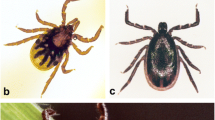Abstract
Tick-borne encephalitis (TBE) virus was determined in ticks I. persulcatus and I. pavlovskyi, collected from humans attacked by ticks in city parks, forest-parks in city outskirts, and in suburban forests, by the enzymelinked immunosorbent assay method (ELISA). It was found that, in spite of I. pavlovskyi being the dominating species in Tomsk and its suburbs, the majority of ticks that attacked humans belonged to I. persulcatus. In ticks that possessed no sighs of the beginning of engorgement (hungry ticks), infestation with TBE virus was revealed by ELISA method less frequently. Percentage of I. persulcatus and I. pavlovskyi, infested with TBE virus, constituted 9.43 % and 3.7 %, respectively. In partly engorged ticks, it constituted 48.78 % and 35.0 %, respectively. In suburban forests, humans were also attacked by I. persulcatus more frequently. In this species, the fraction of infested specimens constituted 12.73 % and 41.54 % in partly engorged and hungry ticks, respectively. In I. pavlovskyi, this percentage constituted 6.06 % and 25 %, respectively. In other words, in all the groups examined, the fraction of infested ticks was noticeably lower in I. pavlovskyi; at the same time, the TBE virus is significantly more frequently revealed in partly engorged ticks.
Similar content being viewed by others
References
Amosov, A.D., Tick-Borne Encephalitis (Koltsovo, 2004) [in Russian].
Melnikova, O.V., Candidate’s Dissertation in Biology, Tomsk, 1995.
Melnikova, O.V., Botvinkin, A.D., and Danchikova, G.A., “Comparative Data on the Degree of Infestation of Hungry and Engorged Taiga Ticks with the Tick-Borne Encephalitis Virus (According to Results of Immune-Enzyme Analysis),” Med. Parazitol. And Parasit. Bolezni 1, 44–49 (1997).
Pankina, T.M. and Romanenko, V.N., “Ecological Associations of Infections with Natural Foci Transmitted to Humans by Ixodid Ticks (Parasitiformes, Ixodidae),” in Biodiversity of Invertebrate Animals (Deltaplan, Tomsk, 2007), pp. 179–185 [in Russian].
Pankina, T.M., Istratkina, S.V., and Zinchenko, N.S., “Comparative Analysis of Percentage of Infested Hungry and Engorged Taiga Ticks in the South of Tomsk Province,” in Parasitological Investigation in Siberia and the Russian Far East (Novosibirsk, 2002), pp. 153–155 [in Russian].
Romanenko, V.N., “Species Composition of Ticks of the Genus Ixodes in Biocenoses Disturbed by Anthropogenic Influence,” in Altai: Ecology and Use of Nature (Proceedings of IVth Russian-Mongol Conference of Young Scientists and Students (Shukshin Biisk Pedagogical Univ., Biisk, 2005), pp. 129–134 [in Russian].
Romanenko, V.N., “The Ecological Basis of the Ethology of Pasture Ixodid Ticks (Parasitiformes, Ixodidae) during Host Search and Attack,” Vestnik Tomsk. Gos. Univ. 298, 224–228 (2007).
Romanenko, V.N. and Chekalina, N.B., “Species Composition of Ixodid Ticks in the Territory of Tomsk,” Vestnik Tomsk. Gos. Univ. 11(Suppl.), 132–134 (2004).
Romanenko, V.N., “Monitoring of the Species Composition and Population Density of Ixodid Ticks in Anthropurgian Biotopes,” Vestnik Tomsk. Gos. Univ. 324, 376–379 (2009).
Sapegina, V.F., “On the Biology of Ixodes pavlovsky,” in Proceedings of Vth Simposium on the Study of the Role of Migrating Birds in the Distribution of Arboviruses (Novosibirsk, Nauka, 1969), p. 72.
Zlobin, V.I. and Gorin, O.Z., Tick-Borne Encephalitis: Etiology, Epidemiology, and Prophylaxis in Siberia (Novosibirsk, Nauka, 1996) [in Russian].
Author information
Authors and Affiliations
Corresponding author
Additional information
Original Russian Text © V.N. Romanenko, L.M. Kondratyeva, 2011, published in Parazitologiya, 2011, Vol. 45, No. 1, pp. 3–10.
Rights and permissions
About this article
Cite this article
Romanenko, V.N., Kondratyeva, L.M. The degree of infestation of ixodid ticks, collected from humans, with the tick-borne encephalitis virus in the territory of tomsk and its environs. Entmol. Rev. 91, 1176–1180 (2011). https://doi.org/10.1134/S0013873811090107
Received:
Published:
Issue Date:
DOI: https://doi.org/10.1134/S0013873811090107




